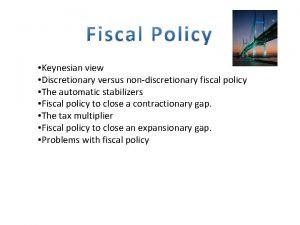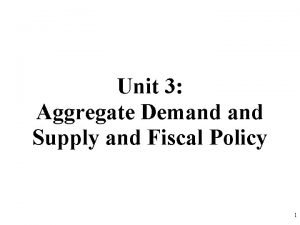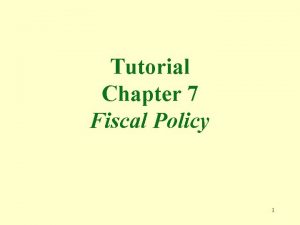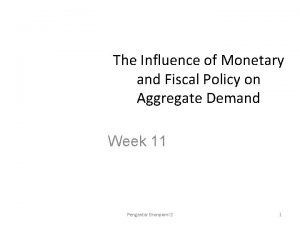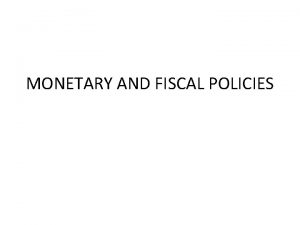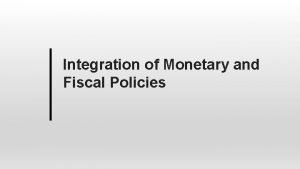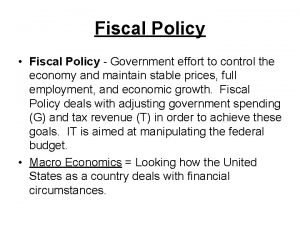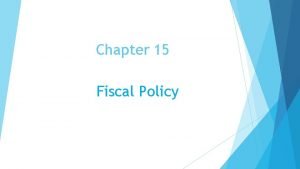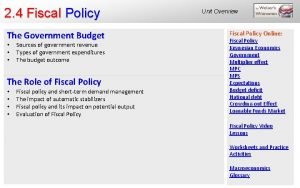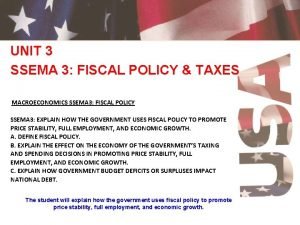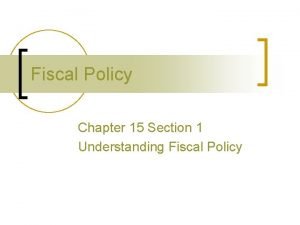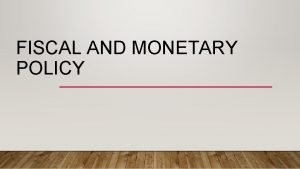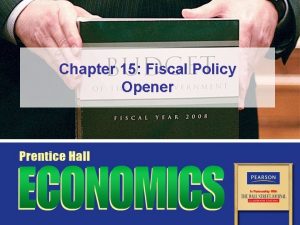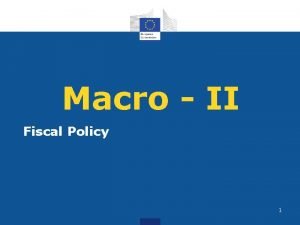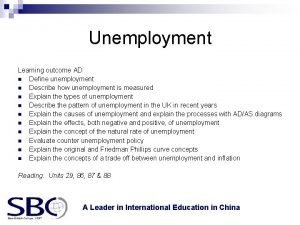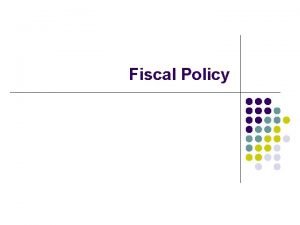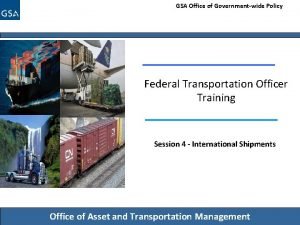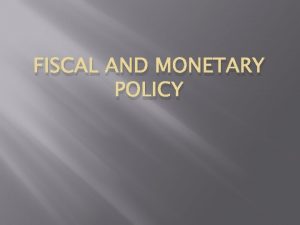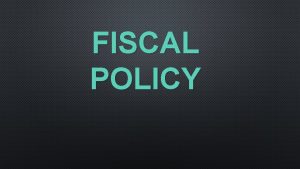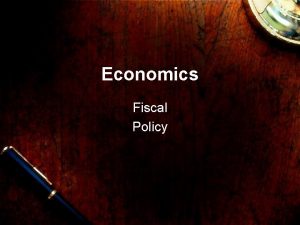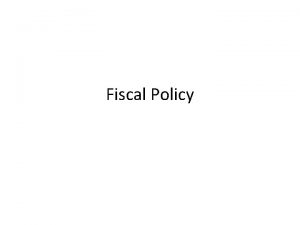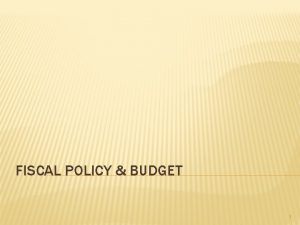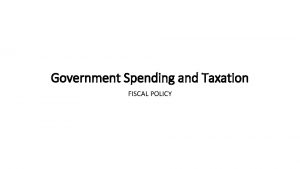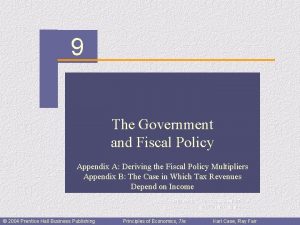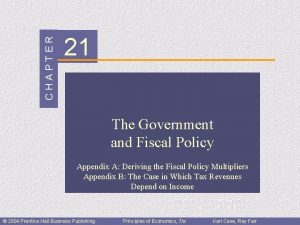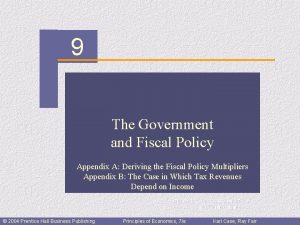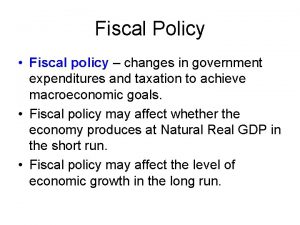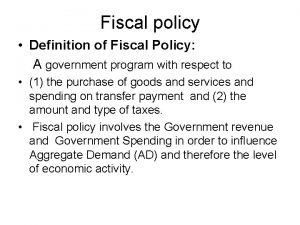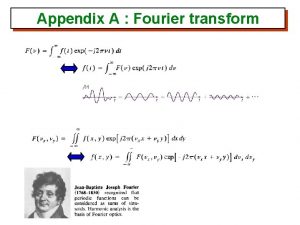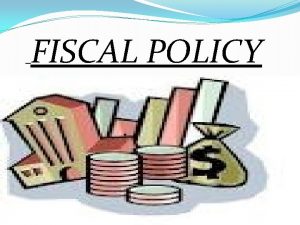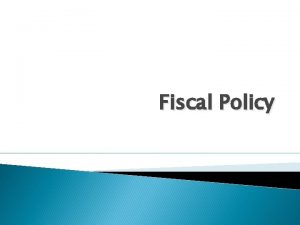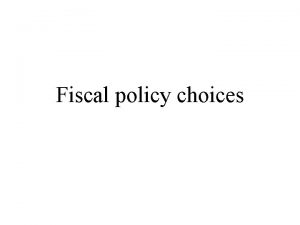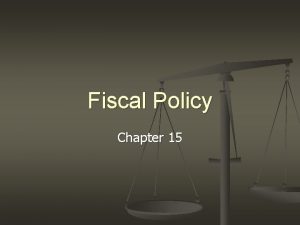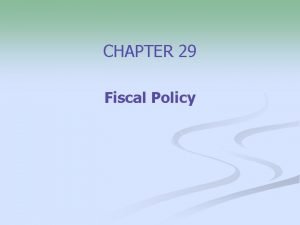CHAPTER 9 The Government and Fiscal Policy Appendix






































- Slides: 38

CHAPTER 9 The Government and Fiscal Policy Appendix A: Deriving the Fiscal Policy Multipliers Appendix B: The Case in Which Tax Revenues Depend on Income Prepared by: Fernando Quijano and Yvonn Quijano © 2004 Prentice Hall Business Publishing Principles of Economics, 7/e Karl Case, Ray Fair

C H A P T E R 9: The Government and Fiscal Policy Government in the Economy • There is much controversy over the appropriate role government should play in the economy. This controversy constantly shifts between positive and normative arguments. • 1. Keynesians believe that the macroeconomy is likely to fluctuate too much if left on its own. • 2. Others (known by the classical school) claim that fiscal and monetary policies are incapable of stabilizing the economy and, even worse, may be destabilizing and harmful. Most agree, however, that governments are important actors in the economy. © 2004 Prentice Hall Business Publishing Principles of Economics, 7/e Karl Case, Ray Fair 2

C H A P T E R 9: The Government and Fiscal Policy • The government can affect the macroeconomy through fiscal policy (its spending and taxing behavior) and monetary policy (the behavior of the Federal Reserve regarding the nation’s money supply). • 1. Fiscal policy includes changes in government purchases of goods and labor, taxes, and/or transfer payments to households with the objective of changing the economy’s growth. • 2. Monetary policy means changes in the quantity of money in circulation with the objective of changing the economy’s growth. Often monetary policy is set as an interest rate target © 2004 Prentice Hall Business Publishing Principles of Economics, 7/e Karl Case, Ray Fair 3

C H A P T E R 9: The Government and Fiscal Policy Government in the Economy • We need to distinguish between variables that the government controls directly and those that are a consequence of government decisions. • 1. For example, government controls tax rates, but tax revenues are also affected by the state of the economy. • 2. Similarly, government spending also depends both on government decisions and on the state of the economy. For example, government spending for unemployment compensation increases when the economy moves into a recession and the unemployment rate rises. © 2004 Prentice Hall Business Publishing Principles of Economics, 7/e Karl Case, Ray Fair 4

C H A P T E R 9: The Government and Fiscal Policy Net Taxes (T), and Disposable Income (Yd) • Discretionary fiscal policy refers to any change in taxes or spending that is intended to influence the future path of the economy. • Net taxes are taxes paid by firms and households to the government minus transfer payments made to households by the government. * Disposable, or after-tax, income Yd equals total income minus taxes. © 2004 Prentice Hall Business Publishing Principles of Economics, 7/e Karl Case, Ray Fair 5

C H A P T E R 9: The Government and Fiscal Policy Adding Net Taxes (T) and Government Purchases (G) to the Circular Flow of Income © 2004 Prentice Hall Business Publishing Principles of Economics, 7/e Karl Case, Ray Fair 6

C H A P T E R 9: The Government and Fiscal Policy Adding Net Taxes (T) and Government Purchases (G) to the Circular Flow of Income • When government enters the picture, the aggregate income identity gets cut into three pieces: • And aggregate expenditure (AE) equals: © 2004 Prentice Hall Business Publishing Principles of Economics, 7/e Karl Case, Ray Fair 7

C H A P T E R 9: The Government and Fiscal Policy The Budget Deficit • A government’s budget deficit is the difference between what it spends (G) and what it collects in taxes (T) in a given period: • If G exceeds T, the government must borrow from the public to finance the deficit. It does so by selling Treasury bonds and bills. In this case, a part of household saving (S) goes to the government. © 2004 Prentice Hall Business Publishing Principles of Economics, 7/e Karl Case, Ray Fair 8

C H A P T E R 9: The Government and Fiscal Policy Adding Taxes to the Consumption Function • The aggregate consumption function is now a function of disposable, or after-tax, income. • What about investment? The government can affect investment behavior through its tax treatment of depreciation and other tax policies. Investment may also vary with economic conditions and interest rates, as we will see later. For our present purposes, we continue to assume that planned investment (I) is independent variable. © 2004 Prentice Hall Business Publishing Principles of Economics, 7/e Karl Case, Ray Fair 9

C H A P T E R 9: The Government and Fiscal Policy Equilibrium Output: Y = C + I + G Finding Equilibrium for I = 100, G = 100, and T = 100 (All Figures in Billions of Dollars) (1) (2) (3) DISPOSABLE OUTPUT NET INCOME (INCOME) TAXES Yd / Y - T Y T (4) CONSUMPTION SPENDING (C = 100 +. 75 Yd) (5) (6) (7) (8) (9) (10) PLANNED UNPLANNED SAVING INVESTMENT GOVERNMENT AGGREGATE INVENTORY ADJUSTMENT S SPENDING PURCHASES EXPENDITURE CHANGE TO (Yd – C) I G C+I+G Y - (C + I + G) DISEQUILIBRIUM 300 100 250 - 50 100 450 - 150 Output 8 500 100 400 0 100 600 - 100 Output 8 700 100 600 550 50 100 750 - 50 Output 8 900 100 800 700 100 100 900 0 1, 100 1, 000 850 100 1, 050 + 50 Output 9 1, 300 1, 200 1, 000 200 100 1, 200 + 100 Output 9 1, 500 1, 400 1, 150 250 100 1, 350 + 150 Output 9 © 2004 Prentice Hall Business Publishing Principles of Economics, 7/e Karl Case, Ray Fair Equilibrium 10

C H A P T E R 9: The Government and Fiscal Policy Finding Equilibrium Output/Income Graphically © 2004 Prentice Hall Business Publishing Principles of Economics, 7/e Karl Case, Ray Fair 11

C H A P T E R 9: The Government and Fiscal Policy The Leakages/Injections Approach • Taxes (T) are a leakage from the flow of income. Saving (S) is also a leakage. • In equilibrium, aggregate output (income) (Y) equals planned aggregate expenditure (AE), and leakages (S + T) must equal planned injections (I + G). Algebraically, © 2004 Prentice Hall Business Publishing Principles of Economics, 7/e Karl Case, Ray Fair 12

C H A P T E R 9: The Government and Fiscal Policy The Government Spending Multiplier • government spending multiplier is defined as the ratio of the change in the equilibrium level of output to a change in government spending. This is the same definition we used in the previous chapter, but now the independent variable is government spending instead of planned investment. © 2004 Prentice Hall Business Publishing Principles of Economics, 7/e Karl Case, Ray Fair 13

C H A P T E R 9: The Government and Fiscal Policy The Government Spending Multiplier • 1. How can the government use taxing and spending policy to increase the equilibrium level of national output? • 2. Increased government spending will lead to increased output, which leads to increased income. More workers are employed, and they in turn act as consumers and spend their incomes. • 3. Output will rise again and so will income, etc. This is the multiplier in action. The government spending multiplier is the same as the investment multiplier. © 2004 Prentice Hall Business Publishing Principles of Economics, 7/e Karl Case, Ray Fair 14

C H A P T E R 9: The Government and Fiscal Policy The Government Spending Multiplier Finding Equilibrium After a $50 Billion Government Spending Increase (All Figures in Billions of Dollars; G Has Increased From 100 in Table 25. 1 to 150 Here) (1) (2) (3) (4) OUTPUT NET DISPOSABLE CONSUMPTION INCOME (INCOME) TAXES SPENDING Yd / Y - T (C = 100 +. 75 Yd) Y T (5) (6) (7) (8) (9) (10) PLANNED UNPLANNED SAVING INVESTMENT GOVERNMENT AGGREGATE INVENTORY ADJUSTMENT S SPENDING PURCHASES EXPENDITURE CHANGE TO (Yd – C) I G C+I+G Y - (C + I + G) DISEQUILIBRIUM 300 100 250 - 50 100 150 500 - 200 Output 8 500 100 400 0 100 150 650 - 150 Output 8 700 100 600 550 50 100 150 800 - 100 Output 8 900 100 800 700 100 150 950 - 50 Output 8 1, 100 1, 000 850 100 150 1, 100 0 1, 300 1, 200 1, 000 200 150 1, 250 + 50 © 2004 Prentice Hall Business Publishing Principles of Economics, 7/e Karl Case, Ray Fair Equilibrium Output 9 15

C H A P T E R 9: The Government and Fiscal Policy The Government Spending Multiplier © 2004 Prentice Hall Business Publishing Principles of Economics, 7/e Karl Case, Ray Fair 16

C H A P T E R 9: The Government and Fiscal Policy The Tax Multiplier • The tax multiplier is the ratio of the change in equilibrium income to a change in taxes. • To reduce unemployment without increasing government spending, taxes must be cut. This increases disposable income, which is likely to add to consumption, which will lead to an increase in output and employment, and hence income, etc. © 2004 Prentice Hall Business Publishing Principles of Economics, 7/e Karl Case, Ray Fair 17

C H A P T E R 9: The Government and Fiscal Policy The Tax Multiplier • A tax cut increases disposable income, and leads to added consumption spending. Income will increase by a multiple of the decrease in taxes. • The multiplier for a change in taxes is smaller than the multiplier for a change in government spending. © 2004 Prentice Hall Business Publishing Principles of Economics, 7/e Karl Case, Ray Fair 18

C H A P T E R 9: The Government and Fiscal Policy Adding the International Sector • Opening the economy to foreign trade adds a fourth component to planned aggregate expenditure—exports of goods and services, or EX. Exports are foreign purchases of goods and services produced in the United States. Opening the economy to the rest of the world also means that U. S. consumers and businesses have greater choice because they can buy foreignproduced goods and services (imports, or IM) in addition to domestically produced goods and services. • We can think of imports (IM) as a leakage from the circular flow and exports (EX) as an injection into the circular flow. (Review Figure 5. 1. ) With imports and exports, the equilibrium condition for the economy is: • open-economy equilibrium: Y = C + I + G + (EX - IM) © 2004 Prentice Hall Business Publishing Principles of Economics, 7/e Karl Case, Ray Fair 19

C H A P T E R 9: The Government and Fiscal Policy The Balanced-Budget Multiplier • The balanced-budget multiplier is the ratio of change in the equilibrium level of output to a change in government spending where the change in government spending is balanced by a change in taxes so as not to create any deficit. © 2004 Prentice Hall Business Publishing Principles of Economics, 7/e Karl Case, Ray Fair 20

C H A P T E R 9: The Government and Fiscal Policy The Balanced-Budget Multiplier Finding Equilibrium After a $200 Billion Balanced Budget Increase in G and T (All Figures in Billions of Dollars; G and T Have Increased From 100 in Table 25. 1 to 300 Here) (1) OUTPUT (INCOME) Y (2) (3) NET DISPOSABLE TAXES INCOME Yd / Y - T T (4) (5) (6) (7) PLANNED CONSUMPTION INVESTMENT GOVERNMENT AGGREGATE SPENDING PURCHASES EXPENDITURE (C = 100 +. 75 Yd) I G C+I+G (8) (9) UNPLANNED INVENTORY CHANGE Y - (C + I + G) ADJUSTMENT TO DISEQUILIBRIUM 500 300 250 100 300 650 - 150 Output 8 700 300 400 100 300 800 - 100 Output 8 900 300 600 550 100 300 950 - 50 Output 8 1, 100 300 800 700 100 300 1, 100 0 1, 300 1, 000 850 100 300 1, 250 + 50 Output 9 1, 500 300 1, 200 1, 000 100 300 1, 400 + 100 Output 9 © 2004 Prentice Hall Business Publishing Principles of Economics, 7/e Karl Case, Ray Fair Equilibrium 21

C H A P T E R 9: The Government and Fiscal Policy Multipliers Summary of Fiscal Policy Multipliers POLICY STIMULUS Governmentspending multiplier Increase or decrease in the level of government purchases: Tax multiplier Increase or decrease in the level of net taxes: Balancedbudget multiplier Simultaneous balanced-budget increase or decrease in the level of government purchases and net taxes: © 2004 Prentice Hall Business Publishing MULTIPLIER Principles of Economics, 7/e FINAL IMPACT ON EQUILIBRIUM Y 1 Karl Case, Ray Fair 22

C H A P T E R 9: The Government and Fiscal Policy The Federal Budget • The federal budget is the budget of the federal government. • The difference between the federal government’s receipts and its expenditures is the federal surplus (+) or deficit (-). © 2004 Prentice Hall Business Publishing Principles of Economics, 7/e Karl Case, Ray Fair 23

C H A P T E R 9: The Government and Fiscal Policy The Federal Budget Federal Government Receipts and Expenditures, 2000 (Billions of Dollars) AMOUNT PERCENTAGE OF TOTAL Receipts Personal taxes Corporate taxes Indirect business taxes Contributions for social insurance Total 1, 010. 1 193. 2 111. 0 720. 6 2, 034. 9 49. 6 9. 5 5. 5 35. 4 100. 0 Current Expenditures Consumption Transfer payments Grants-in-aid to state and local governments Net interest payments Net subsidies of government enterprises Total Current Surplus (+) or deficit (-) (Receipts - Current Expenditures) 514. 1 831. 9 274. 2 236. 9 52. 5 1, 909. 6 + 125. 3 26. 9 43. 6 14. 4 12. 4 2. 7 100. 0 Source: U. S. Department of Commerce, Bureau of Economic Analysis. © 2004 Prentice Hall Business Publishing Principles of Economics, 7/e Karl Case, Ray Fair 24

C H A P T E R 9: The Government and Fiscal Policy The Federal Government Surplus (+) or Deficit (-) as a Percentage of GDP, 1970 I-2003 II © 2004 Prentice Hall Business Publishing Principles of Economics, 7/e Karl Case, Ray Fair 25

C H A P T E R 9: The Government and Fiscal Policy The Debt • The federal debt is the total amount owed by the federal government. The debt is the sum of all accumulated deficits minus surpluses over time. • Some of the federal debt is held by the U. S. government itself and some by private individuals. The privately held federal debt is the private (nongovernment-owned) portion of the federal debt. © 2004 Prentice Hall Business Publishing Principles of Economics, 7/e Karl Case, Ray Fair 26

C H A P T E R 9: The Government and Fiscal Policy The Federal Government Debt as a Percentage of GDP, 1970 I-2003 II The percentage began to fall in the mid 1990 s. © 2004 Prentice Hall Business Publishing Principles of Economics, 7/e Karl Case, Ray Fair 27

C H A P T E R 9: The Government and Fiscal Policy The Economy’s Influence on the Government Budget • Automatic stabilizers are revenue and expenditure items in the federal budget that automatically change with the state of the economy in such a way as to stabilize GDP. © 2004 Prentice Hall Business Publishing Principles of Economics, 7/e Karl Case, Ray Fair 28

C H A P T E R 9: The Government and Fiscal Policy The Economy’s Influence on the Government Budget • Fiscal drag is the negative effect on the economy that occurs when average tax rates increase because taxpayers have moved into higher income brackets during an expansion. © 2004 Prentice Hall Business Publishing Principles of Economics, 7/e Karl Case, Ray Fair 29

C H A P T E R 9: The Government and Fiscal Policy The Economy’s Influence on the Government Budget • The full-employment budget is what the federal budget would be if the economy were producing at a full-employment level of output. © 2004 Prentice Hall Business Publishing Principles of Economics, 7/e Karl Case, Ray Fair 30

C H A P T E R 9: The Government and Fiscal Policy The Economy’s Influence on the Government Budget • The cyclical deficit is the deficit that occurs because of a downturn in the business cycle. • The structural deficit is the deficit that remains at full employment. © 2004 Prentice Hall Business Publishing Principles of Economics, 7/e Karl Case, Ray Fair 31

C H A P T E R 9: The Government and Fiscal Policy Review Terms and Concepts automatic stabilizers fiscal drag balanced-budget multiplier fiscal policy budget deficit full-employment budget cyclical deficit government spending multiplier discretionary fiscal policy monetary policy disposable, or after-tax, income net taxes privately held federal debt federal budget structural deficit federal debt tax multiplier federal surplus (+) or deficit (-) © 2004 Prentice Hall Business Publishing Principles of Economics, 7/e Karl Case, Ray Fair 32

C H A P T E R 9: The Government and Fiscal Policy Appendix A: Deriving the Fiscal Policy Multipliers The government spending and tax multipliers algebraically: © 2004 Prentice Hall Business Publishing Principles of Economics, 7/e Karl Case, Ray Fair 33

C H A P T E R 9: The Government and Fiscal Policy Appendix A: Deriving the Fiscal Policy Multipliers • The balanced-budget multiplier is found by combining the effects of government spending and taxes: increase in spending: - decrease in spending: = net increase in spending © 2004 Prentice Hall Business Publishing • The balanced-budget multiplier equals one. An increase in G and T by one dollar each causes a one-dollar increase in Y. Principles of Economics, 7/e Karl Case, Ray Fair 34

C H A P T E R 9: The Government and Fiscal Policy Appendix B: The Case In Which Tax Revenues Depend on Income © 2004 Prentice Hall Business Publishing Principles of Economics, 7/e Karl Case, Ray Fair 35

C H A P T E R 9: The Government and Fiscal Policy Appendix B: The Case In Which Tax Revenues Depend on Income © 2004 Prentice Hall Business Publishing Principles of Economics, 7/e Karl Case, Ray Fair 36

C H A P T E R 9: The Government and Fiscal Policy Appendix B: The Case In Which Tax Revenues Depend on Income The Government Spending and Tax Multipliers Algebraically: © 2004 Prentice Hall Business Publishing Principles of Economics, 7/e Karl Case, Ray Fair 37

C H A P T E R 9: The Government and Fiscal Policy Appendix B: The Case In Which Tax Revenues Depend on Income • The government spending and tax multipliers when taxes are a function of income are derived as follows: © 2004 Prentice Hall Business Publishing Principles of Economics, 7/e Karl Case, Ray Fair 38
 Macroeconomics unit 5 lesson 2 activity 45
Macroeconomics unit 5 lesson 2 activity 45 Unit 3 aggregate demand and aggregate supply
Unit 3 aggregate demand and aggregate supply Unit 3 aggregate demand aggregate supply and fiscal policy
Unit 3 aggregate demand aggregate supply and fiscal policy Discretionary vs non discretionary fiscal policy
Discretionary vs non discretionary fiscal policy Unit 3 aggregate demand aggregate supply and fiscal policy
Unit 3 aggregate demand aggregate supply and fiscal policy Inflation
Inflation Example fiscal policy
Example fiscal policy Fiscal policy practice
Fiscal policy practice Components of fiscal policy
Components of fiscal policy Crowding out effect of fiscal policy
Crowding out effect of fiscal policy Instruments of fiscal policy
Instruments of fiscal policy Instruments of fiscal policy
Instruments of fiscal policy Fiscal policy definition
Fiscal policy definition Fiscal demand side policy
Fiscal demand side policy Fiscal policy to control inflation
Fiscal policy to control inflation Contractionary fiscal policy
Contractionary fiscal policy Instruments of fiscal policy
Instruments of fiscal policy Crowding out effect macroeconomics
Crowding out effect macroeconomics Demand side fiscal policy definition
Demand side fiscal policy definition Expansionary monetary policy aggregate demand
Expansionary monetary policy aggregate demand Crowding out effect of fiscal policy
Crowding out effect of fiscal policy Example of expansionary fiscal policy
Example of expansionary fiscal policy Fiscal policy
Fiscal policy Goals of fiscal policy
Goals of fiscal policy Fiscal vs monetary policy
Fiscal vs monetary policy Goals of fiscal policy
Goals of fiscal policy Fiscal policy
Fiscal policy Classical unemployment diagram
Classical unemployment diagram Fiscal policy in macroeconomics
Fiscal policy in macroeconomics Features of fiscal policy ppt
Features of fiscal policy ppt Fiscal policy definition
Fiscal policy definition Fiscal deficit meaning
Fiscal deficit meaning Transportation terminology
Transportation terminology Senior policy officer scottish government
Senior policy officer scottish government What are the three levels of government
What are the three levels of government Hình ảnh bộ gõ cơ thể búng tay
Hình ảnh bộ gõ cơ thể búng tay Slidetodoc
Slidetodoc Bổ thể
Bổ thể Tỉ lệ cơ thể trẻ em
Tỉ lệ cơ thể trẻ em



